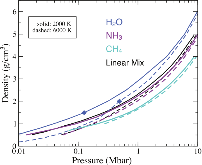Uranus evolution models with simple thermal boundary layers
- Univ. of Rostock (Germany). Inst. of Physics; Univ. of California, Santa Cruz, CA (United States). Dept. of Astronomy and Astrophysics
- Castilleja High School, Palo Alto, CA (United States); Univ. of California, Santa Cruz, CA (United States). Science Internship Program
- Univ. of Rostock (Germany). Inst. of Physics
- Lawrence Livermore National Lab. (LLNL), Livermore, CA (United States)
- Saratoga High School, Saratoga, CA (United States); Univ. of California, Santa Cruz, CA (United States). Science Internship Program
- Lawrence Livermore National Lab. (LLNL), Livermore, CA (United States); Univ. of California, Santa Cruz, CA (United States). Dept. of Astronomy and Astrophysics
- Univ. of California, Santa Cruz, CA (United States). Dept. of Astronomy and Astrophysics
The strikingly low luminosity of Uranus (Teff ≃ Teq) constitutes a long-standing challenge to our understanding of Ice Giant planets. Here we present the first Uranus structure and evolution models that are constructed to agree with both the observed low luminosity and the gravity field data. Here, our models make use of modern ab initio equations of state at high pressures for the icy components water, methane, and ammonia. Proceeding step by step, we confirm that adiabatic models yield cooling times that are too long, even when uncertainties in the ice:rock ratio (I:R) are taken into account. We then argue that the transition between the ice/rock-rich interior and the H/He-rich outer envelope should be stably stratified. Therefore, we introduce a simple thermal boundary and adjust it to reproduce the low luminosity. Due to this thermal boundary, the deep interior of the Uranus models are up to 2–3 warmer than adiabatic models, necessitating the presence of rocks in the deep interior with a possible I:R of 1 × solar. Finally, we allow for an equilibrium evolution (Teff ≃ Teq) that begun prior to the present day, which would therefore no longer require the current era to be a ”special time” in Uranus’ evolution. In this scenario, the thermal boundary leads to more rapid cooling of the outer envelope. When Teff ≃ Teq is reached, a shallow, subadiabatic zone in the atmosphere begins to develop. Its depth is adjusted to meet the luminosity constraint. This work provides a simple foundation for future Ice Giant structure and evolution models, that can be improved by properly treating the heat and particle fluxes in the diffusive zones.
- Research Organization:
- Lawrence Livermore National Laboratory (LLNL), Livermore, CA (United States)
- Sponsoring Organization:
- USDOE National Nuclear Security Administration (NNSA)
- Grant/Contract Number:
- AC52-07NA27344
- OSTI ID:
- 1497277
- Report Number(s):
- LLNL-JRNL-738448; 891299
- Journal Information:
- Icarus, Vol. 275, Issue C; ISSN 0019-1035
- Publisher:
- ElsevierCopyright Statement
- Country of Publication:
- United States
- Language:
- English
Web of Science
Similar Records
The Formation of Uranus and Neptune: Fine-tuning in Core Accretion
The measured compositions of Uranus and Neptune from their formation on the CO ice line










